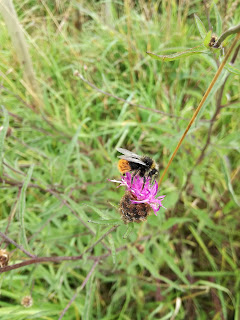Over the Easter weekend, we had some warm sunshine, so we visited The Mound to plant a few hedgerow whips along the line of the first line of trees. The idea is to thicken up the planting to provide a wind shelter and screening now that the Leylandii hedge is no longer there, as the strongest winds come from the West. In all, 34 whips were planted, some Hawthorn, Green Dogwood and Hazel at a spacing of 20-30cm. In addition, some of the older Red Dogwood had spread widely and layered itself. So I pruned off the branches which had roots, and planted them along the line, too.
 |
| A volunteer from Amfreville, Normandy and a Twinning Friend |
Some of the trees are already in flower. One or two of the Wild Cherry were spectacular with their white blossom.
 |
| Wild Cherry |
I noticed that for the first year, some Field Maples are mature enough to flower.
 |
| Strange green Field Maple flowers |
Sloe (Blackthorn) and Goat Willow were also in bloom.
Goat Willow catkins provide a lot of nectar and were very popular with Bumblebees and other insects on the wing.
 |
| Buff-tailed Bumblebee Queen |
There were also Goldfinches, Blackbirds, Sparrows, Great Tit, Magpies and Wood Pidgeons in flight or in the hedges.
At the top, primroses were in bloom. These were a gift from a volunteer in 2019, who sadly is no longer with us and they remind us of her. Alongside them, our first native Wild Daffodil is in bloom. This was planted there from locally-sourced bulbs. They thrive in damp woodland glades. Their seeds are fertile and they will spread.
 |
| In memory of Marion |
 |
| Native Devon Daffodil |



















































